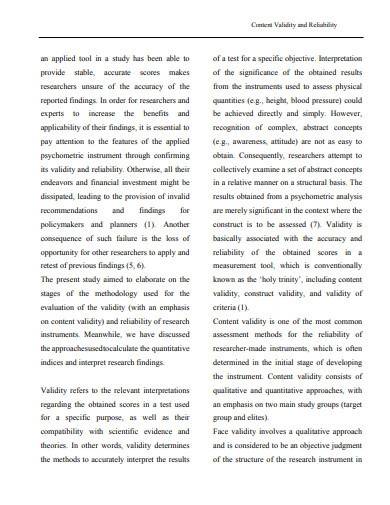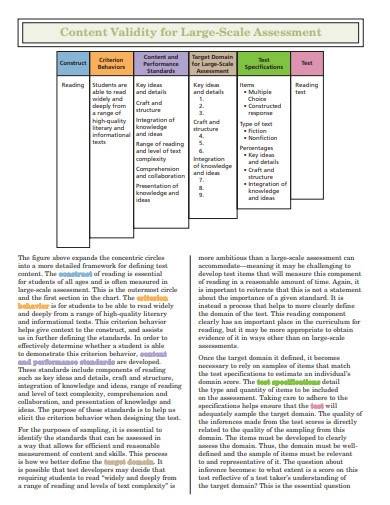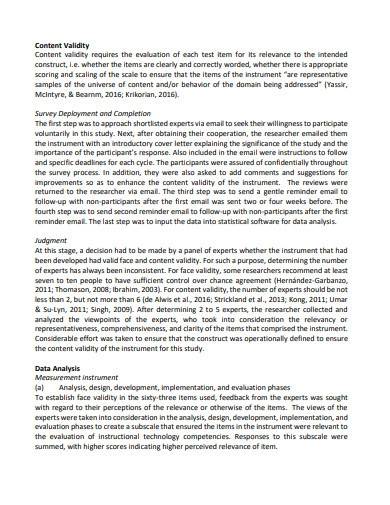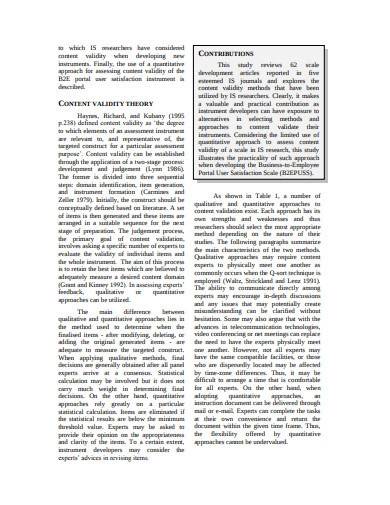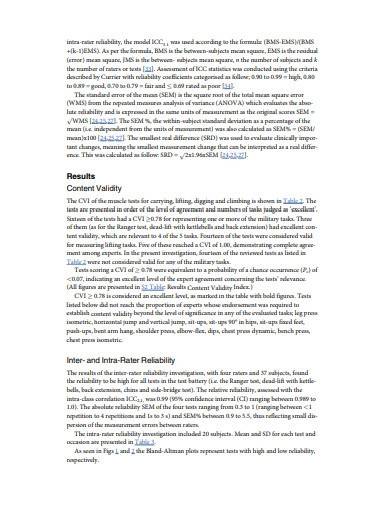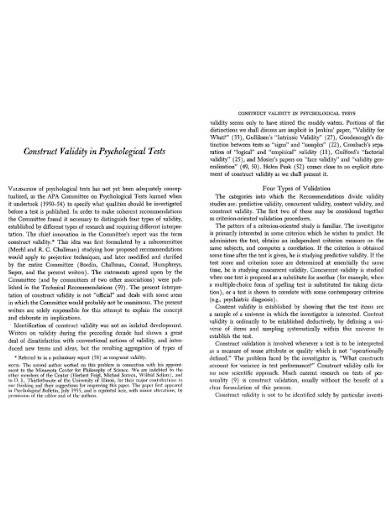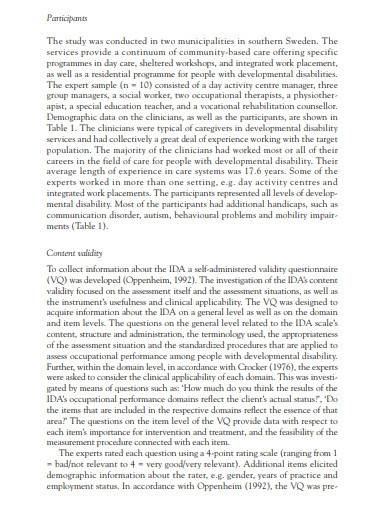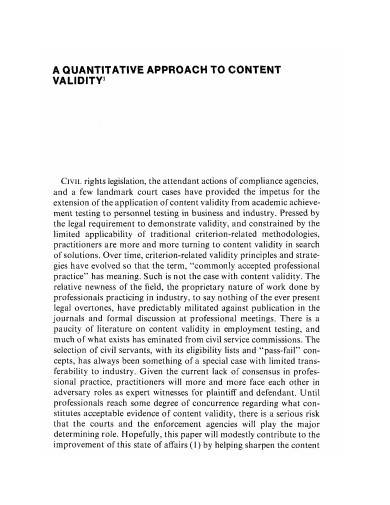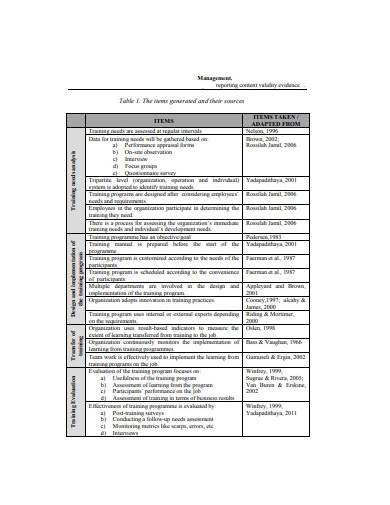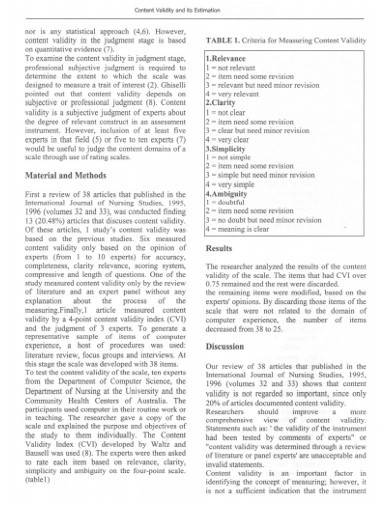To establish content validity, experts in the field typically review the test items and provide feedback samples on whether they are relevant and representative of the domain being measured. This feedback can be used to revise and improve the test items to ensure that they are measuring what they are intended to measure.
Content validity is important in ensuring that a test case or formative assessment is an accurate measure of the construct being measured, and it is one of the key criteria used to evaluate the quality control of a test or summative assessment instrument.
FREE 10+ Content Validity Samples & Templates in PDF
1. Content Validity & Reliability Template
2. Content Validity for Large Scale Assessment
3. Construct Validity Data Analysis Template
4. Construct Validity Theory Template
5. Basic Construct Validity Template
6. Construct Validity in Psychological Sample
7. Simple Participant Content Validity
8. Standard Quantitative Content Validity
9. Basic Content Validity Template
10. Qualitative Study Capital Content Validity
11. Content Validity Estimation Template
What is Content Validity?
Content validity is a critical concept in the field of psychological assessment report, and it refers to the degree to which a test or assessment instrument measures what it is intended to measure. The concept of content validity is essential because it ensures that the results of an assessment instrument are meaningful and accurate, and that the instrument is appropriate for the specific purpose for which it was designed.
How To Make Content Validity?
To establish content validity, it is necessary to first define the construct that the test is intended to measure. This involves identifying the key elements or dimensions of the construct, as well as the specific behavior chart or skills gap analysis that are associated with each dimension. To ensure content validity in a psychological assessment or test, the following steps can be taken:
Step 1- Define the construct
The first step in creating a test with content validity is to clearly define the construct that the test is intended to measure. This involves identifying the key dimensions or subskills of the construct. Once the construct has been defined, the next step is to develop test items that cover each of the key dimensions or subskills. The test items should be written in a clear and concise manner, and should accurately reflect the knowledge or skills that are being measured.
Step 2-Review test items
After the test items have been developed, they should be reviewed by experts in the field to ensure that they are relevant and representative of the domain being measured. This feedback can be used to revise and improve the test items as necessary.
Step 3-Pilot test the instrument
Once the test items have been reviewed and revised, the next step is to pilot test the instrument with a sample of individuals who are representative of the population being measured. The results of the pilot test can be used to evaluate the content validity of the test items and the instrument as a whole.
Step 4- Analyze results
The results of the pilot test should be analyzed to determine whether the test items are measuring what they are intended to measure, and whether the test as a whole is an accurate representation of the construct being measured. This can be done through statistical analysis, such as factor analysis or item analysis.
How is content validity established?
Content validity is established by defining the construct being measured, developing test items that cover each of the key dimensions or subskills of the construct, reviewing the test items to ensure that they are relevant and representative of the domain being measured, piloting the instrument, analyzing the results, and revising the instrument as necessary.
Can a test have content validity without construct validity?
A test can have content validity without construct validity, but it is not desirable. A test with good content validity but poor construct validity may accurately measure the content being assessed, but it may not measure the underlying construct or concept that it is intended to measure.
How can I ensure that a test has content validity?
To ensure that a test has content validity, it is necessary to define the construct being measured, develop test items that cover each of the key dimensions or subskills of the construct, review the test items to ensure that they are relevant and representative of the domain being measured, pilot the instrument, analyze the results, and revise the instrument as necessary.
In conclusion, content validity is an essential concept in psychological assessment, and it ensures that risk assessment instruments are measuring what they are intended to measure. To establish content validity, it is necessary to define the construct being measured, develop test items that cover each of the key dimensions and associated skills, and review the test items to ensure that they are relevant and representative of the domain being measured. By ensuring that assessment instruments have good content validity, we can ensure that the results are meaningful and accurate, and that they provide useful information for a variety of purposes.
Related Posts
FREE 10+ Construct Validity Samples & Templates in MS Word | PDF
FREE 10+ Code of Human Research Ethics Samples & Templates in MS Word | PDF
FREE 10+ Biography Research Report Samples and Templates in PDF
FREE 10+ System Documentation Samples & Templates in MS Word | PDF
FREE 10+ Process Document Samples & Templates in MS Word | PDF
FREE 10+ Action Research Samples & Templates in PDF
FREE 10+ Longitudinal Research Samples & Templates in PDF | MS Word
FREE 10+ Causal Research Samples & Templates in MS Word | PDF
FREE 10+ Client Discovery Samples & Templates in MS Word | PDF
FREE 10+ Null Hypothesis Samples & Templates in MS Word | PDF
FREE 9+ Product Knowledge Samples & Templates in PDF
FREE 10+ Software Documentation Samples & Templates in MS Word | PDF
FREE 10+ Exploratory Research Samples & Templates in PDF | MS Word
FREE 10+ Experimental Research Samples & Templates in MS Word | PDF
FREE 10+ Descriptive Research Samples & Templates in PDF

